16.01.10 Lk. 23:32-34a; Mk. 15:23, 25, 27-28 (See also Mt. 27:33-34, 38; Jn. 19:18) 9:00 a.m. – noon; First Day of Passover.
JESUS IS CRUCIFIED
Lk. 32 Two others — criminals — were also led away to be executed with Him. 33 When they arrived at the place called The Skull, they crucified Him there, along with the criminals, one on the right and one on the left. [34 Then Jesus said, “Father, forgive them, because they do not know what they are doing.”] And they divided His clothes and cast lots.
Mk. 23 They tried to give Him wine mixed with myrrh, but He did not take it. 25 Now it was nine in the morning when they crucified Him.
Jesus received the wrath of men and God on this day.
- From 9:00 until 12:00 noon, He received the wrath of men.
- From 12:00 noon until 3:00, He received the wrath of God.
“Two others – criminals – were also led away to be executed with Him.” A common robber or bandit was known as a lestai. Previously, when Jesus was arrested, He asked the soldiers if He was a lestai.[1] But the Romans never crucified common robbers or bandits; they crucified those who rebelled against Roman authority. Those persons, however, were often robbers as well.
According to Roman practice, all three men were probably forced to walk along the longest route through the most crowded streets of Jerusalem. This was to install a strong sense of fear in the common people who may have had thoughts of insurrection. By this time, all of Jerusalem probably had heard that Jesus was tried and about to be crucified. Jesus and the other two men were each accompanied by four soldiers, and all twelve were under the command of a centurion. They were commissioned to perform four acts of service:
- Guard the prisoner enroute from any persons in the crowd who would attempt to free him or kill him.
- Insure the prisoner’s safe arrival to the place of execution.
- Soldiers were to stay with each prisoner until death was assured.
- At times, soldiers guarded the deceased body so the family could not give their loved on a decent burial.[2]
Jesus was crucified between two thieves,[3] as predicted by the prophet Isaiah, who said He was numbered with the transgressors (53:12). The Romans and religious elite promoted the image of Jesus as simply another criminal who needed to die. They were correct concerning His need to die, but did not understand the reason why. Christ died between two condemned men; one chose life through salvation and the other chose death and eternal damnation. Jesus is the only option between life and death.
The two criminals who were crucified with Jesus have at times been identified as robbers. However, robbery was not a crime punishable by crucifixion. The Greek word is testes, meaning “insurrectionists” (Mk. 15:27), which affiliated them with anti-Roman Zealot and possibly revolutionary messianic activities. Theft and similar crimes were often committed as a means of support by these criminals.[4]
“Jesus said, “Father, forgive them, because they do not know what they are doing.’” This is the first of seven last sayings of Jesus as He was dying upon the cross of Calvary. This could very well have been the ultimate test of forgiveness – by Someone who lived a perfect life and had every right to call judgment down from heaven upon those who were killing Him.[5]
Whenever men died on the cross, they screamed in agony, shouted expressions of pain and cursed those who crucified them and all the gods they could think of. In sharp and stunning contrast, Jesus bore His pain in quietness and forgiveness. Even if Jesus was not God, His death would have convinced any witness that He was God – so profound was His response to the shameful torture that ended His life.
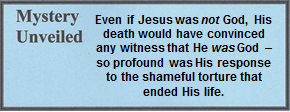
This profound statement, “Father, forgive them, because they do not know what they are doing,’” was spoken by the one who knew no sin and had every reason in the world to destroy those who had inflicted such massive pain upon Him. The phrase reflects agape or “God kind of love,” to a lost and dying humanity. Jesus died as He lived; He practiced what He preached; He lived and died His sermon that He preached on the beatitudes. His words would later be uttered by thousands of martyrs, who died for the faith beginning with Stephen, whose dying words were “Lord, do not hold this sin against them” (Acts 7:60). Luke recorded in Acts 7:54-8:3 the events of the first martyrdom and the fact that Saul of Tarsus approved his execution by rioters. The love of Jesus demonstrated by Stephen with his dying breath was probably the beginning of Saul’s conversion process. The compassion that Saul witnessed was foreign to this zealous Pharisee. No doubt his incredible rage was evidence that his conscience was under strenuous guilt. The one who suffered the most that day may not have been Stephen, but the man who eventually became the greatest apostle and wrote more New Testament books than any other author.
If any of those who crucified Jesus were condemned to Hell, it was not because they crucified Him, but because they failed to accept His forgiveness. If they could find salvation after this horrible deed, then most certainly anyone else can also find it also. The question then must be asked, “What is forgiveness?” It is the restoration of a fellowship. The fellowship between God and man was broken with the sin of Adam and Eve and was restored when Jesus paid the price for the sins of humanity. However, for that fellowship and restoration to be functional in one’s life, it must be accepted.
This phrase, “Jesus said, “Father, forgive them, because they do not know what they are doing’” also alludes to the words spoken by the high priest on the Day of Atonement. His statement of forgiveness made a powerful impact, for the Jews would realize the blood of Jesus had paid the sacrifice for their sins, just as the priest intervened on their behalf and the people received atonement of sins by the shed blood of the sacrificial scapegoat. When the priest laid his hands upon the scapegoat, he prayed this prayer:
O God, your people, the House of Israel, have committed iniquity, transgressed, and sinned before you. O God, forgive I pray, the iniquities and transgressions and sins which your people, the House of Israel, have committed and transgressed and sinned before you; as it is written in the law of your servant Moses, “For on this day shall atonement be made for you to cleanse you; from all your sins shall you be made clean before the Lord” (Lev. 16:30).
Mishnah, Yoma 6.2
The reflection of the priestly prayer of Jesus (Jn. 17) is obvious. What a contrast there was between the prayers of Jesus and those of the Sadducees. Jesus said “Father, forgive them…” (Lk. 23:34) while the Sadducees prayed (or said) “Let His blood be on us and on our children” (Mt. 27:25). Some scholars have said the religious leaders and Pilate did know or should have known that what they were doing was wrong and, therefore, Jesus did not extend forgiveness to them.
“They tried to give Him wine mixed with myrrh.” Crucifixion was so horrible, that at times, wealthy women and hardened soldiers demonstrated compassion by giving the dying criminals wine with either bitter-tasting myrrh or frankincense which dulled the pain.[6] The Talmud recorded the following custom of the day:
When one is led out to execution, he is given a goblet of wine containing a grain of frankincense, in order to benumb his senses, for it is written, Give strong drink unto him that is ready to perish, and wine unto the bitter in soul (Prov. 31:6). And it has also been taught: The noble women in Jerusalem used to donate and bring it.
Babylonian Talmud, Sanhedrin 43a
Jesus refused to take an analgesic of wine as He was committed to carry our pain for us (see 16.01.13). Ironically, the gifts offered to Him as a new-born king were the same gifts offered to Him as a dying criminal.
“Now it was nine in the morning when they crucified Him.” Literally, it was the “third hour” in Hebraic time. It was also the same time that the high priest in the temple offered a sacrificed lamb before God for the sins of the people. What irony, the high priest, who had just condemned the Lamb of God to a Roman cross, was sacrificing a lamb to God as a sin offering. What the gospel writer called the third hour Josephus called the ninth hour – Roman time – with the following comments concerning the Passover sacrifices:
So these high priests upon the coming of their feast, which is called Passover, when they slay their sacrifices, from the ninth hour till the eleventh….
Josephus, Wars 6.9.3 (423a)
16.01.10.Q1 Where were the nails placed in the body of Jesus?
If the biblical account is to be literally understood, then the nails that held Jesus to the cross were not placed where traditional opinion says they were. Jesus was/is the sacrificial “Lamb of God” and sacrificial lambs were not to have a single broken bone. So likewise Jesus was to die without a single broken bone. So the obvious question is then, how were the nails placed in His hands and feet without breaking a single bone? If a nail was placed in the palm of His hand, it would have been impossible not to break any bones.
In Roman times the forearm and wrist were considered a part of the hand; the entire area from the fingernails to the elbow. If the nails were placed in the wrist, as most scholars believe, the iron spike would have been placed between the Ulnar and Median nerves, causing a pulsating pain like electrical shocks through the arms and shoulders. The Shroud of Turin and other bone discoveries indicate the nails were most frequently placed through the wrists.[7]
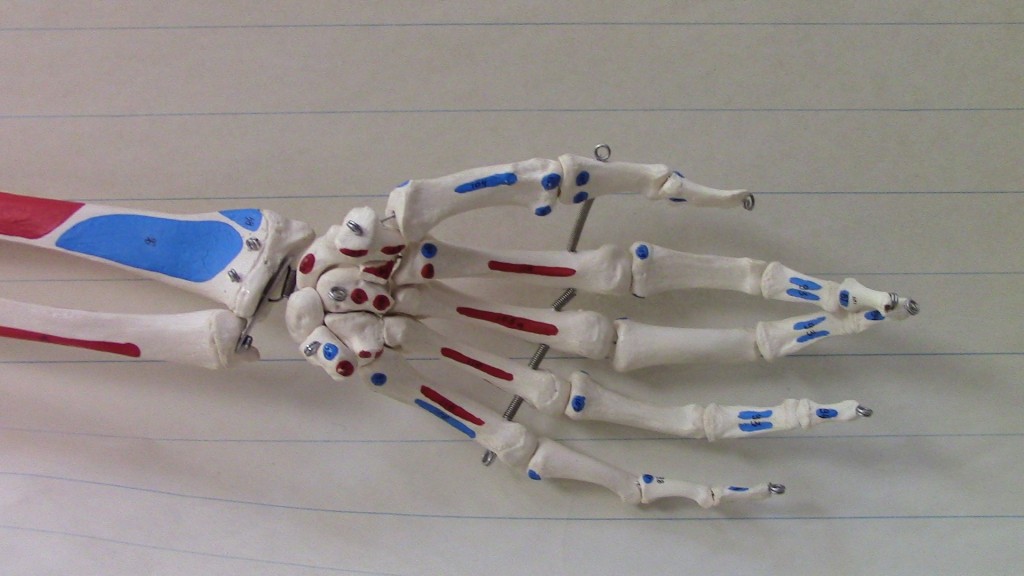
16.01.10.A. BONES OF A HAND. This skeletal view of a human hand illustrates that it is impossible to place a nail through the palm of a hand without breaking any of the small bones that are in the palm. Photograph by the author.
Concerning the placement of nails to secure the feet to the post of the cross, many artistic renderings show one foot on top of the other and both are held in place with a long Roman nail. However, a view of the bone structure (16.01.10.B) reveals that it is nearly impossible to nail through a foot in this manner without breaking a bone, and definitely impossible if that same nail were to penetrate both feet. Therefore, the only possible conclusion is that Jesus had each foot nailed into a side of the post. The nail would have gone through the flesh and tendons been behind the ankle bone. To support this view, a few graffiti sketches of crucifixion have survived the centuries and all of them show a foot nailed into each side of the post (see 16.01.10.C).
Of the thousands of men, and of a few women who were crucified in ancient Israel, the remains of only one skeleton have been found that suggests death by this method.[8] In 1968 an ossuary was discovered in a tomb in Giv’at Ha-Mivtar, a suburb of Jerusalem. It contained the remains of a crucified prisoner, by the name of Yohanan Ben Ha’galgol. It also had a nail along the side of an ankle, indicating that each ankle was nailed into opposite sides of the post. In this case, four nails were used in the crucifixion (see 16.01.10.B below).[9] In addition, a small piece of olive wood was found in the tomb that originally was between the ankle and the head of the nail. Since olive trees are not very tall, this suggests that Ha’galgol was not crucified on a cross, but on a living olive tree. Researchers estimate that the nails used were approximately 5 to 7 inches long (13 to 18 cm) with a square shaft (3/8 inch or 1 cm.). To the left is a reconstructed model of a foot and crucifixion nail.
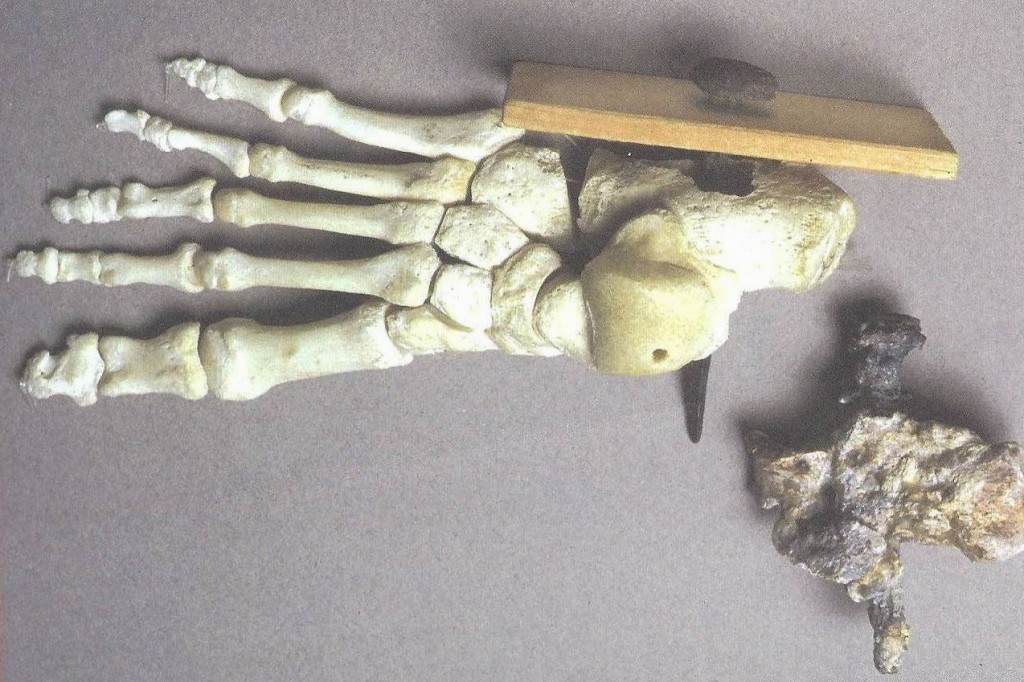
16.01.10.B. CRUCIFIED ANKLE BONE ATTACHED TO OLIVE WOOD. Shown in the lower right corner are the nail, anklebone, and a piece of olive wood that evidently was secured to the nail. Above it is a reconstructed foot with nail. It is believed that a piece of wood was under the head of the nail to secure the foot to the live tree or to a crux (post).
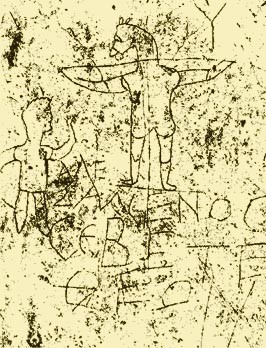
16.01.10.C. ANTI-CHRISTIAN GRAFFITI. This second century Roman Period anti-Christian cartoon depicts a man, who might have been a soldier, worshiping a crucified figure with a donkey’s head. This confirms the accusations by the church father Tertullian who said that Christians were accused of worshiping the head of a donkey.[10] The drawing was discovered in an ancient imperial palace on the Palatine Hill in Rome in 1856, and is now in the Palatine Antiquarium.[11] The Greeks and Romans believed that Jews and Christians worshiped a god in the form of a donkey. Photo by Wikipedia Commons.
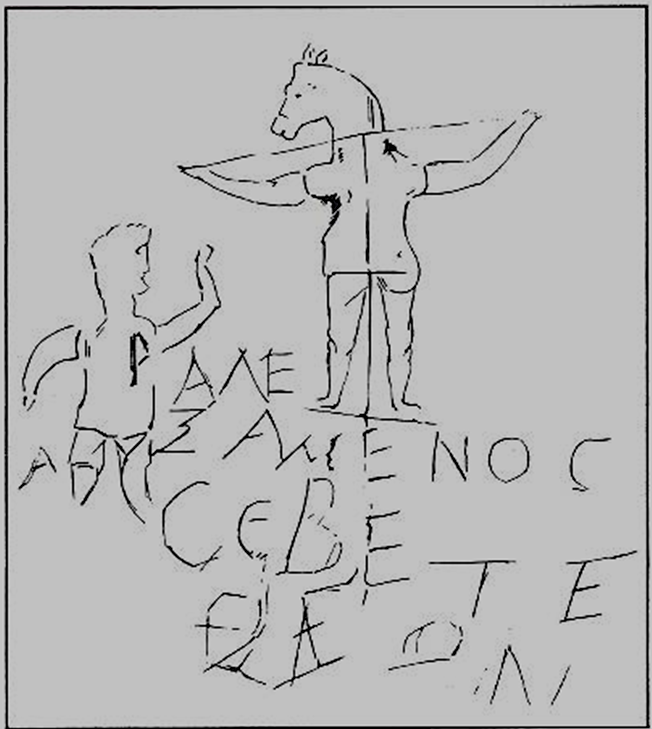
16.01.10.D CLARIFIED SKETCH OF ANTI-CHRISTIAN GRAFFITI. A clarified sketch of the original drawing reveals the vulgar attitude an artist had toward a Christian named Alexamenos. It is inscripted ΑΛΕΞΑΜΕΝΟΣ (ΑΛΕΞΑΜΕΝΟC) ΣΕΒΕΤΕ (CEBETE) ΘΕΟΝ, which translates as “Alexamenos respects (or worships) God.” The cross is shaped like a letter Greek “T” or tau.[12] Photo by Wikipedia Commons.
It is amazing that some critics claim that the early church fathers created the crucifixion story along with the accusation that Jesus was against the Roman government. For the early church fathers to do so would have been suicidal – why would they deliberately say that Jesus was anti-Roman, when that was the charge that caused anti-Christian hatred and sent thousands to the cross, gladiator fights, and lion pits? Obviously some critical arguments are not well thought out. Furthermore, it is well known that early Christians identified themselves with a Staurogram – a combination of the Greek letters tau and rho that look like a human figure hanging on a cross. The Bodmer Papyrus P66, is a nearly complete edition of the gospel of John[13] dated to the early 3rd century, and it contains ten staurograms.[14]
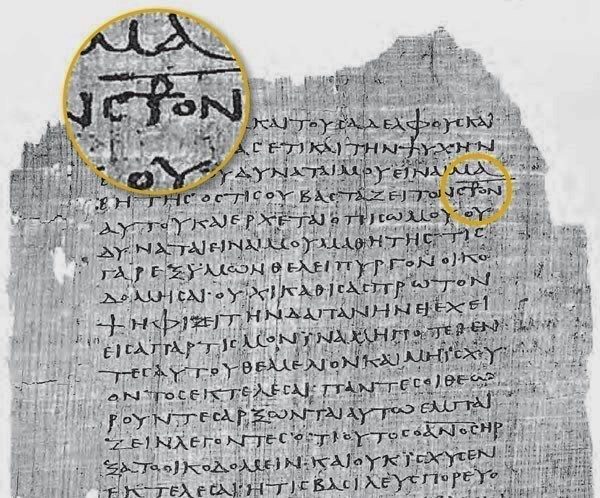
16.01.10.E. THE EARLIEST KNOWN IMAGE OF JESUS ON THE CROSS, One of the earliest manuscripts (circa. 200) of the Gospel of John, the Bodmer Papyrus P66, has ten staurograms – two Greek letters (tau and rho) that, when combined, produce the image of a person on a cross. Photo by Wikipedia Commons.
As previously stated, when a prisoner was crucified on a low cross beam, four soldiers could easily lift the patibulum (cross beam) to its proper position on the top of the post and held in place by a mortise and tenon joint or with pins. Therefore, no nails were needed to hold the two pieces of timber together. If the prisoner was to be hung from a high cross, then ladders or forks were used to lift and secure him in place, but this was rare. Once hung in place, the prisoner had his feet nailed to the post, but with his knees slightly bent. Either way – low cross or high cross – the dying man would push himself up with excruciating pain to gain a breath of air. The open wounds on the back rubbing against the splintery post simply enhanced his agony. It was the ultimate punishment.
Crucifixion victims often spent three or four days in dying agony until death gave them sweet relief.
In the case of Jesus, three hours on the cross was a relatively brief time when compared to the dying time of other prisoners. This indicates that the scourging was unusually hard on Him physically, plus He carried the heavy load of the sins of humanity.
A traditional act of mercy on the part of the soldiers was to break the legs or spear the right side to hasten death. This procedure was so common it was even given a name: crurifragium.[15] In the case of Jesus, the legs were not broken, but His side was speared and, according to the Shroud of Turin, it was the right side. An infantry spear or lance (length: 5-6 ft.; 1.5-1.8 m.) in the right side was the custom of the Roman military.[16] If the legs were broken, death transpired within minutes, because the victim would not have been able to elevate himself to inhale. The fact that the pierced sword caused blood and water to gush out of the body clearly confirms that Jesus was dead. This would be a difficult point to explain in future years by those who claimed that Jesus simply fainted and was later revived.
According to Roman military law, if the soldiers had permitted a condemned man to live, they would have been executed as well. They were not about to take that chance and, therefore, one of them thrust a spear into the side of Jesus.[17] In addition, at times guards remained with the crucified man even after death to prevent family or friends from taking the body for a dignified burial before it was absolutely too late.[18] Their presence was to insure uttermost humiliation and shame for the criminal and his family. To have a family member crucified was bad enough, but to have his or her body devoured by wild animals was beyond shame (Jer. 7:33; 19:7; Deut. 28:26). A proper burial was so highly valued in ancient times that it can be hardly understood or appreciated today.
The weight of the body upon the stretched arms and joints caused immense pain. In order to breathe, one had to push up with his feet to inhale. While this relieved the pain for a moment in the arms, it accelerated the pain in his feet and ankles. For this reason, each of the seven last statements spoken by Jesus was relatively short, barely long enough to be said with a single breath of air, as pain and muscle cramps increased. Every movement caused searing pain throughout the entire body, as the open muscle tissues scraped against the rough surface of the wooden post. The nails rubbing against raw nerves sent painful surges – like lightning bolts – through arms and legs that quiver.[19] The symphony of agony from so many points, and even insects, had become acute. Slowly, death came as breathing became increasingly difficult, the muscles relaxed and bodily functions ceased. The stomach stopped functioning, the dry tongue swelled making speech nearly impossible, and blood pressure drops. There was not a great deal of blood loss from the crucifixion, but there was from the previous scourging. This was so painful that the Romans created a new word to describe it; “excruciating,” which comes from the Latin excruciatus, meaning “out of the cross.”[20]
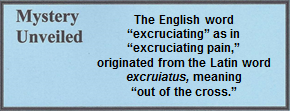
Finally, the One who gave the breath of life to His most favored creation in the Garden of Eden, died of asphyxia – the loss of breath. Secondary causes of death probably were shock, dehydration, and congestive heart failure.[21] Jesus was hung to die; not only for our sins, but also that we may be recreated in the image of the One who created us in the Garden.
[1]. Lang, Know the Words of Jesus. 369-70, 395.
[2]. Pentecost, The Words and Works of Jesus Christ. 479, 482.
[3]. The pseudepigraphal books have a number of suggestions concerning their names, which clearly demonstrates why these writings must be evaluated with suspicion. Suggested names are Dismas and Gestas, as in the Acts of Pilate. Other suggested names are Zoathan and Chammata, Joathas and Maggatras, and Titus and Dumatchus. See Jordan. Who’s Who in the Bible. 240.
[4]. Guinness, Mysteries of the Bible. 333-34.
[5]. Those who attempted to kill Him or were responsible for His death, such as the Sadducees, Pilate, Herod the Great and others, all died horrible deaths.
[6]. Lang, Know the Words of Jesus. 398.
[7]. Edwards, Gabel, and Hosmer, ”On the Physical Death of Jesus Christ.” 1459.
[8]. Caba. “Crucifixion: History and Practice.” 12-14; Thiede and d’Ancona. The Quest for the True Cross. 66-67.
[9]. For an excellent study on the subject, see Robinson. “Crucifixion in the Roman World: The Use of Nails at the Time of Christ.” 25-59.
[10]. Tertullian, Apologeticus pro Christianis 16; Tertullian, Ad Nationes 1.2.
[11]. Metzger, Goldstein, and Ferguson, Great Events of Bible Times. 162; Thiede and d’Ancona. The Quest for the True Cross. 114-15.
[12]. For further study, see Witherington III, “Images of Crucifixion: Fresh Evidence.” 28.
[13]. For other papyri containing portions of the Epistles and Gospel of John, see http://catholic-resources.org/John/Papyri.html. Retrieved March 3, 2015. http://www.biblicalarchaeology.org/daily/biblical-topics/crucifixion/the-staurogram/ Retrieved March 4, 2015.
[14]. Hurtado, Larry W. “The Staurogram: Earliest Depiction of Jesus’s Crucifixion.” 50. http://en.wikipedia.org/wiki/Papyrus_66 and https://www.era.lib.ed.ac.uk/bitstream/handle/1842/1204/staurogram+chapter-+Manuscripts+volumea.pdf;jsessionid=04E12A1BCDA79BE1A197C31EDD2A4FB3?sequence=1 Retrieved March 3, 2015.
[15]. Stein, R. Jesus the Messiah. 254; Farrar, Life of Christ. 2, 423.
[16]. Edwards, Gabel, and Hosmer, ”On the Physical Death of Jesus Christ.” 1460.
[17]. Edwards, Gabel, and Hosmer, ”On the Physical Death of Jesus Christ.” 1463.
[18]. Crossan, Who Killed Jesus? 161.
[19]. Dauer, How Jesus Died: The Final 18 Hours. (Video).
[20]. Edwards, Gabel, and Hosmer, ”On the Physical Death of Jesus Christ.” 1461.
[21]. Edwards, Gabel, and Hosmer, ”On the Physical Death of Jesus Christ.” 1461; Stein, R. Jesus the Messiah. 245.